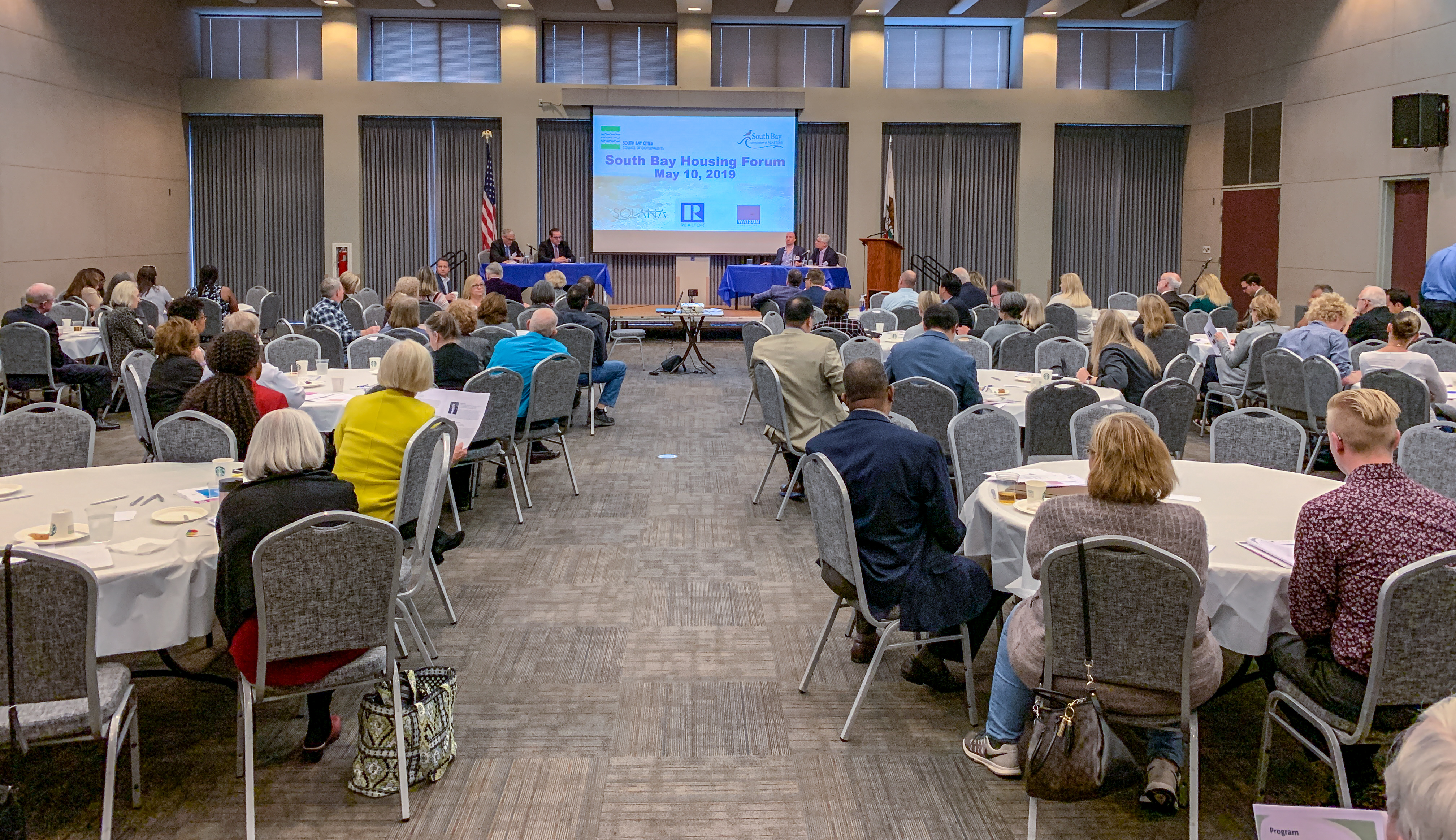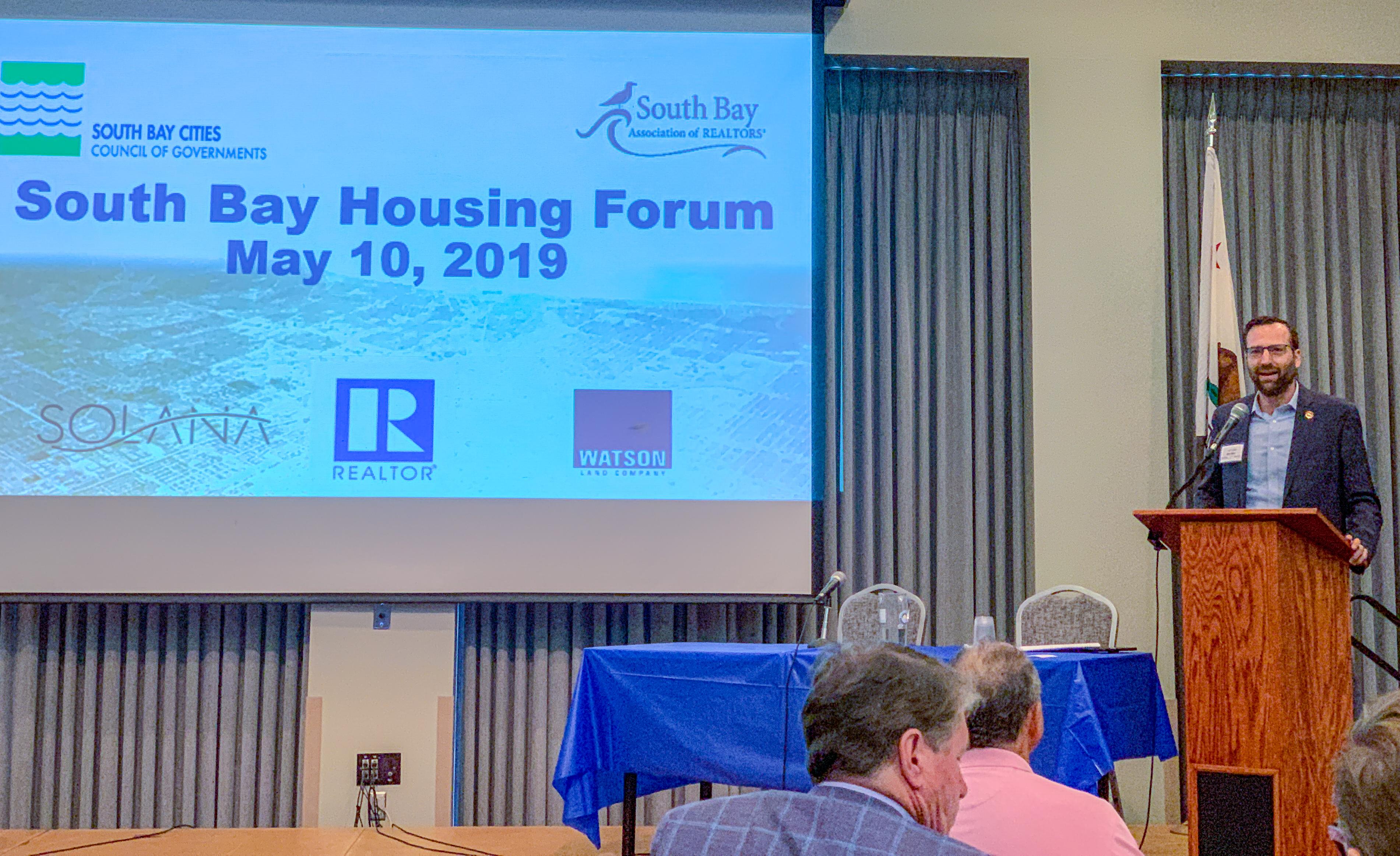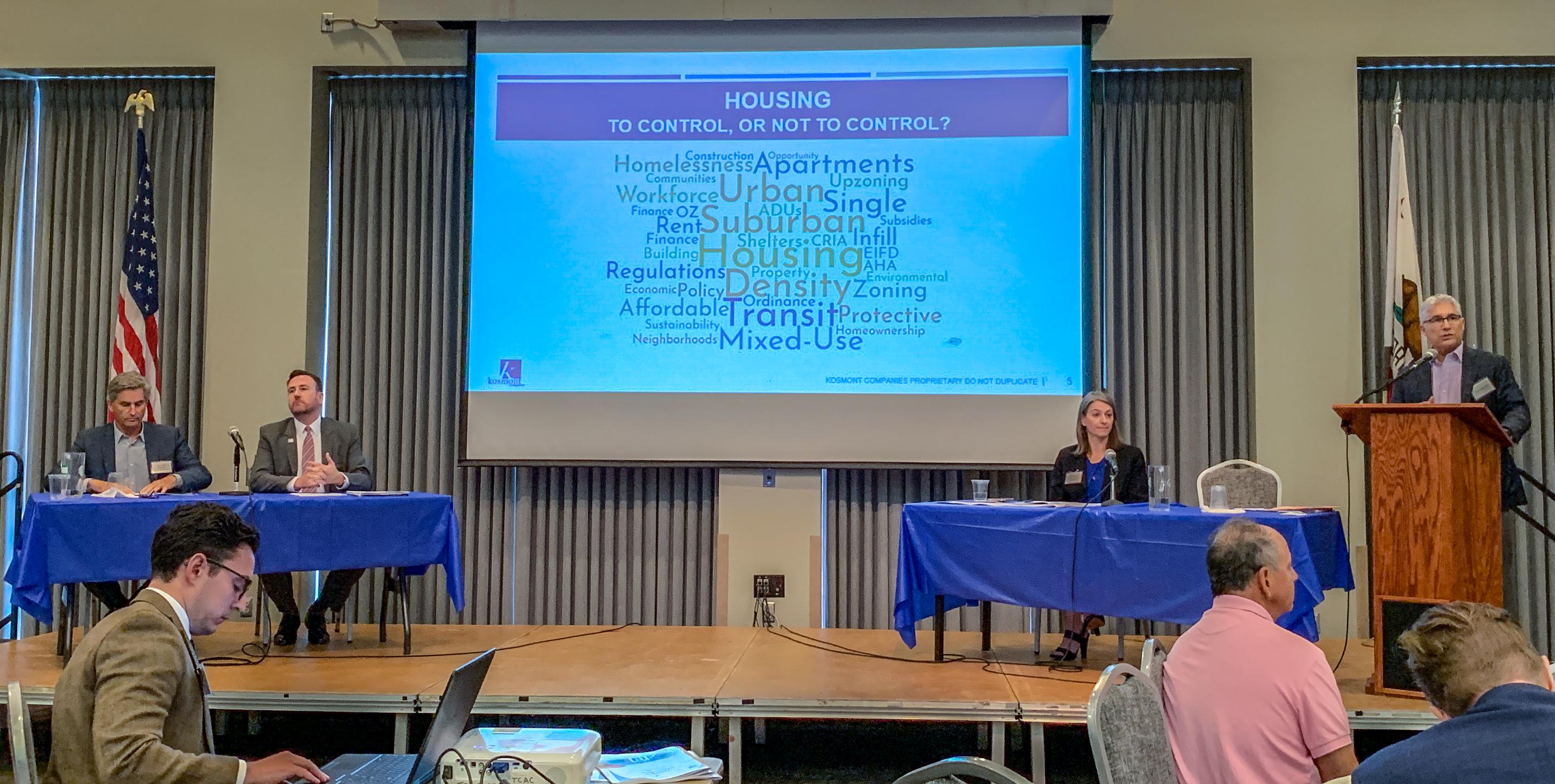
One of the most heated issues facing California today is housing. It is no surprise that housing dominates the dialogue in Sacramento as lawmakers debate a variety of topics like homelessness, tenant rights, densification and its environmental effects. To address this pressing issue, the South Bay Association of Realtors, South Bay Cities Council of Governments and National Association of Realtors* held a half-day forum, featuring numerous local elected officials and three panels of professionals in many different areas of expertise. They voiced a wide range of opinions on California’s current situation as well as the merit and impact of SB 50. Most agreed that housing is a complicated and divisive issue.
The honorable Patrick J. Furey, Mayor of Torrance, opened the meeting stating, “Housing is not a dirty word.” He went on to say that the need for housing is real, but so is the need to preserve the charm and quality of life we have in our neighborhoods. “We must find a way to accommodate both these needs. Status Quo is not an option.”
The first panel discussion, “Making the Case for Housing,” included three advocates of high density housing. Their presentations centered on the state’s failure to sustain its middle class and millennial populations and its loss of jobs to other states due to stagnating wages coupled with soaring housing costs. Kenneth Stahl, of Chapman University, explained that housing growth has not kept up with population growth over the last decade and rocketing home prices are a result of low housing growth. He blamed local governments for denying housing permits by bending to the pressure of baby boomer homeowners seeking to preserve their property values and quality of life. As a result, he inferred, we are experiencing the highest rates of homelessness, intergenerational inequity and racial segregation. To be equitable, he concluded, people must accept a change of character to their neighborhoods. Greg Anderson of Shea Properties made the point that corporations in California cannot afford to raise wages to accommodate the growing housing costs. Off put by housing prices for their employees and the high tax rate, corporations are passing over California to set up facilities in more affordable areas like Austin and Nashville. Mark Wilbur of The Employers Group added that employees, of which many are millennials, want to live near their work. They gravitate toward urbanization, walkability and diversity. Wilbur claimed that the shortage of housing will be the biggest issue of the 2020 election. The country has a shortage of 7.3 million homes. Forty percent of that number, or 3.4 million home, makes up California’s shortage. As a result, Governor Newsom’s priority is to add 3.5 million units by 2025. Those cities that fail to comply with the State’s housing supply law (like Huntington Beach) can expect a lawsuit. The legislative branch has also been busy introducing multiple new housing statutes. One of the most divisive is Senator Scott Wiener’s housing bill, SB 50. Applying a one size fits all approach, the bill would allow residential buildings of at least four or five stories within half a mile of rail stations and ferry terminals.The bill would also remove density limits within a quarter mile of stops on bus lines with frequent service and in high-income census tracts with lots of jobs and good schools, regardless of their proximity to transit. That would open neighborhoods previously zoned for single-family homes to apartments and condominiums.
Addressing the issues of SB 50 was keynote speaker the Honorable Ben Allen, California State Senator of 26th District. Senator Allen is one of many local officials who have written letters in opposition to the bill. He stressed, however, the severity of the housing shortage, which has been in the making for over a decade (since the Great Recession) and has left many people homeless especially after an eviction. He recognized how tough it is for young people trying to enter the job market in the state to stay above water. They often are strapped with huge college debt and steep housing costs. Wiener’s bill aims to increase the supply of units across the state thereby lowering the cost of housing. Allen brought up the point that densifying cities can be costly. Cities may be forced to improve their infrastructures to accommodate the growth. Unfortunately, residential building yields little in tax money. Where would the money come for increased services like police, fire, water, roads, sewer, schools? The bill would create a “smoldering pot of demands.” Allen praised Wiener for forcing the housing issue but has serious concerns about how the bill is structured. Although Wiener claimed cities will drag their feet unless they are pushed, Allen countered that cities need to have more control and be subject to incentives and disincentives. Rezoning is best left to the cities, who have unique challenges.

The second panel of speakers discussed “What Different Option Are Available for Housing” to address the shortage. Darin Chidsey, COO of Southern California Association of Governments, stated that there is no easy solution to the problem. The SCAG region (which includes Ventura, LA, Orange, San Bernardino, Riverside and Imperial counties) must take into consideration not only housing but also air quality, transit, climate change effects (e.g., increasing temperature, beach erosion and health alerts) and changing demographics. The birthrate is dropping and 65% of the population by 2030 will be 65 years of age or above. Many will be staying in their homes longer as lifespan averages expand and aging in place becomes easier with the help of the home care industry and Uber or Lyft. “No one thing (like more housing) can fix the problems facing California.” Anne McIntosh, Community Development Director of Manhattan Beach, offered five nuggets of wisdom from her experience with city planning:
- Rail transit-oriented housing is a good land use model, but it doesn’t make sense everywhere. The market determines its success.
- State mandates for local housing have never worked and are not the way to solve the problem. They only add more bureaucracy.
- Accessory dwelling units and mixed-use housing are effective ways to solve the housing shortage.
- Cities should not expect overnight results but think forward. Twenty-five years can go by quickly.
- Cities should not focus solely on the desires of current residents but also the needs and desires of future residents.
Wally Siembab, Research Director of the South Bay Cities Council of Governments (SBCCG), is another opponent of the one-size fits all approach to the housing issue. He also does not want to see changes at the expense of the environment. SBCCG voted to oppose SB 50. The housing problem should not be solved at the State level using a “meat ax” approach but instead needs to be carefully modified at the local level using a “scalpel” approach. He added that SB 50’s transit-housing plan is problematic in the South Bay because transit is poor here, and ridership is down. He also claimed that “affordable housing should be built on affordable land.” Build horizontal mixed-use neighborhoods in underperforming malls. To reduce the need for automobile transportation, create a network of compact, destination rich neighborhood centers, fiber-rich and digitally enhanced with a strong regional telework program. Currently, 70% of trips in the South Bay are under 3 miles. If destinations were clustered and a micro-mobility infrastructure created, residents would use alternative means of transportation like walking, bicycles, golf carts, e-trikes, scooters, etc. Siembab stressed that we need to be forward thinking and consider new formats in housing style that are designed for the priorities of today and tomorrow, not those of a century ago. We need to plan for tomorrow by using 21st century teleservices and sustainable zero-emissions transportation. We need to avoid overnight redevelopment but make incremental changes and consider how housing impacts services, health, quality of life. He warned that what we build today we will be stuck with for the next 50 to 100 years. He hopes we build it right, environmentally sound. “We cannot grow infinitely.” He concluded by saying that increasing density does not necessarily result in lower housing costs. To make his point, he reminded the audience that Hong Kong has both the highest residential density and the highest housing cost in the world.
The last panel of speakers tackled the topic “The South Bay and Sacramento: Perspective on Housing.” Jeff Kiernan, Regional Public Affairs Manager of the League of California Cities, spoke of the Democrats having significant leverage and being able to readily advance their legislative agenda over those of Republicans. Even moderates (of both parties) have been sidelined. Gov. Newsom’s “lofty goal” is to increase the rate of current housing unit construction fivefold. Kiernan stressed the importance and value of maintaining local control by cities to enhance and maintain the quality of life for all Californians. Jeli Gavric is a Legislative Advocate for the California Association of REALTORS (C.A.R) in Sacramento, where she is the association’s land use and environmental lobbyist. C.A.R. is a strong supporter of SB50 as key to addressing the housing shortage for millennials in California. She elaborated on the fact that millennials have housing needs different from those of typical suburban single-family homeowners. They prefer urban living with a wide variety of housing types and styles in walkable areas. She reasoned that an increase in housing supply will ultimately reduce housing prices and therefore increase affordability. Achieving housing affordability in urban and suburban areas will result in reduced equity growth going forward for existing homeowners. For her, legislation such as SB50 is key to facilitating the ability of more people “to hop on the equity train of ownership.” The Honorable Bill Brand, Mayor of Redondo Beach, commented on the inequities in Regional Housing Needs Assessment (RHNA) allocation process, resulting in Redondo Beach receiving an allocation he felt was disproportionate with other cities in the South Bay. Mayor Brand cited hard numbers to support the fact that residential housing related services cost his city considerably more than their share of the property tax revenue associated with housing. He added that even if SB 50 does not pass, cities will have to deal with hundreds of other bills that will significantly curtail local autonomy. Along with the mayors of Cupertino and Palo Alto, he has been proactive in putting an Initiative on the ballot that would insure local control over planning and land use within their cities. “Zoning should be a municipal affair.” The State’s broad-brush stroke housing legislation, he claimed, makes it hard for local elected officials to maintain quality of life for their residents.

The takeaway from the forum is that the housing issue is complicated and that there is no one size fits all solution. The challenge is to find common ground addressing all aspects of the housing issue. Housing and jobs are important but so are the health and quality of life of all people who will live in the South Bay.
*This Forum was also sponsored by Watson Land Company, a developer of master planned industrial parks, and Reylenn Properties, LLC. Reylenn, the developer of Torrance Solana, a proposed 248 luxury, market-rate, apartment development to be located in South Torrance at the intersection of Hawthorne Blvd & Via Valmonte (Butcher-Hill site).